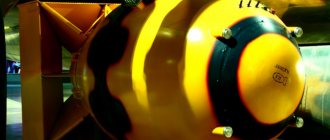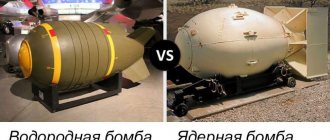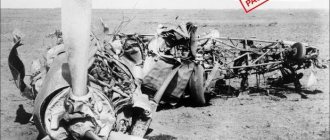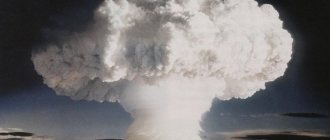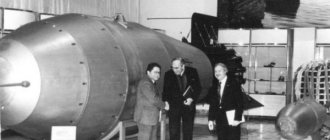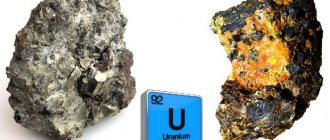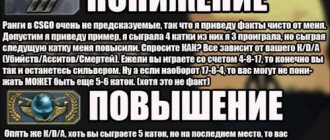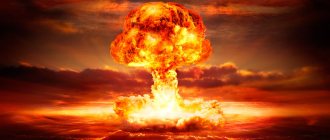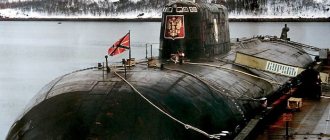In the middle of the last century, the design of the atomic bomb was a closely guarded secret. Only an extremely limited circle of scientists close to the governments of the great powers were privy to this secret. Other mortals were only supposed to know that the formula E=mc² had something to do with the matter, that uranium was needed, and that all this was very powerful witchcraft.
Now everything has changed. Nowadays, the structure of the atomic bomb can be found out from open sources, but still few people understand how the most terrible weapon of mankind works. But it's worth figuring it out. For example, to determine where in books and films there are fantastic assumptions, where there is anti-scientific nonsense, and where the author read the reference book but did not understand anything.
Atomic weapons are based on the chain reaction effect. The nuclei of some isotopes of heavy metals are unstable and, having captured a passing neutron, immediately decay. In this case, both large fragments and several more free neutrons appear. They can trigger the decay of other nuclei, resulting in the release of even more neutrons. This avalanche-like process leads to a rapid release of energy - a nuclear explosion, the power of which is equivalent to 25 tons of TNT for every gram of decayed isotope.
Of course, a chain reaction will not start if the metal ingot is not large enough and most of the released neutrons simply fly away beyond its boundaries. For an explosion to occur, the amount of fissile material must exceed a certain critical mass. The minimum explosive quantity of the substance is 47 kilograms for uranium-235 and 10 kilograms for plutonium-239: in practice, only these two metals are used to create nuclear explosive devices.
Already the second “Fat Man” bomb dropped on Nagasaki had a ball charge
It may seem that creating a critical mass is easy: take two ingots of uranium, one and a half pounds each, and combine them. But this is not the best idea, which is why complex implosion or ball charges are used in the manufacture of nuclear weapons. Their effect is based on the fact that when a force is applied to the surface of a sphere, as it approaches its center, the pressure will increase by the square. As a result, the spherical charge is a “matryoshka doll”. The outer spherical layer is formed by ordinary “chemical” explosives, on the surface of which 64 detonators are evenly distributed. All detonators must fire simultaneously - then an explosion occurs, which generates a shock wave directed towards the center.
If at least one detonator does not fire in time, the compression will be asymmetrical and will only lead to the destruction of the ammunition. And this serves as reliable protection. A bomb can fall out of a plane, fall along with the plane, burn in a carriage as a result of a train accident, or even be hit by an artillery shell (although the latter was only tested on mock-ups). In the worst case, this will lead to the detonation of conventional chemical explosives, but there will be no unplanned detonation of a nuclear charge.
Following the explosives in the ball charge is a layer of aluminum. Light metal is needed to increase the radius of the charge, and therefore the resulting pressure in the center of the sphere. A tamper is placed inside the hollow aluminum sphere - a hollow sphere made of depleted uranium, which serves as a massive piston
Through the tamper, the concentric shock wave is transmitted to the third, smallest hollow sphere, made of nuclear explosives - uranium or plutonium. In the very center there is a miniature tritium-based neutron source. The mass of “nuclear explosives” in a ball charge is usually one and a half to three times less than the critical mass. The development of a chain reaction in ammunition occurs due to additional neutrons emitted by tritium, an increase in the density of the metal at the moment of maximum compression, and also because the uranium tamper reflects the neutrons generated during the decay of nuclei inward, preventing them from leaving the reaction zone.
Ball charge of the first Soviet atomic bomb RDS-1 (Photo: Museum of Nuclear Weapons RFNC-VNIIEF)
The “ball” design makes it possible to safely insert a supercritical charge of a fissionable isotope into the ammunition. The record here belongs to the British: they produced a thin-walled plutonium sphere, the mass of which exceeded the critical mass by 12 times! But then the sons of Foggy Albion were simply fed up with ambition: how could it be that the Soviets and the States have a hydrogen bomb, but they don’t. The kingdom spent a year's supply of fissile materials to produce this technological miracle.
It is possible to increase the power of ammunition without such a waste of scarce materials. In an activated ball charge, chain decay continues not until the fuel is exhausted, as in a conventional bomb, but until the device is destroyed. The evaporated uranium ball no longer has sufficient density to support a chain reaction. In the first implosion bombs, only 10% of the nuclear explosive had time to burn out before the charge was dispersed, while in modern ones this figure ranges from 30 to 60%. The degree of burnout can be increased by providing additional compression. For this, a large - up to a quarter ton - charge of chemical explosive is used. Increasing the thickness of the tamper also helps. Of course, the additional inert mass is only able to withstand a nuclear flame bursting from the reaction zone for a short moment. But when the intensity of the reaction increases exponentially, even this moment is of great importance.
At the stage of burning lithium and uranium, the thermonuclear bomb resembles a star in design. It consists entirely of plasma - hot ionized gas, but is denser than lead.
The destructive power of modern nuclear weapons can be increased even more by using a capsule with thermonuclear fuel. Next to the first ball charge, which plays the role of a detonator, a second one is placed, arranged somewhat differently. Instead of a layer of chemical explosives, it is covered with inert plastic. Immediately below it is a depleted uranium tamper. And between the tamper and the central hollow sphere made of plutonium, there is a layer of lithium-6 deuteride, a compound of a light lithium isotope with heavy hydrogen. This white powder is not radioactive and is completely safe as long as you do not pour water on it.
The detonation of the first ball charge turns the plastic layer into superheated plasma, the pressure of which leads to the implosion of the thermonuclear capsule. Its plutonium core reaches a critical density and also explodes. Lithium, absorbing the resulting neutrons, decomposes into helium and superheavy hydrogen - tritium. The temperature at the shock wave collision front at this moment is sufficient for the thermonuclear fusion reaction involving deuterium and tritium to begin. And this means a third explosion - about a hundred times stronger than the first two.
Tsar Bomba, aka “Kuzka’s Mother”, the most powerful thermonuclear bomb in history (model, Croquant | CC BY-SA 3.0)
But the detonation of thermonuclear fuel is only the second phase of a thermonuclear explosion. If a nuclear explosion stops after the destruction of the explosive device, then the mechanism of the hydrogen bomb continues to work after the transition to the plasma state of aggregation. The fusion of heavy and superheavy hydrogen nuclei produces helium nuclei and neutrons. The energy of neutrons is so high that they are not captured by heavy nuclei, but break them up, like a billiard ball breaking a pyramid.
Under a hail of neutrons, uranium-238 reacts, which is quite safe under normal conditions. This is the third phase of the explosion, increasing its power five more times. The contribution of energy from the decay of uranium nuclei is not so great, but this process generates new clouds of neutrons. And the denser the neutron flux, the more lithium will turn into tritium, the higher the efficiency of the explosive device will be. A hydrogen bomb can be assembled in such a way that the burnup of each of the three components - plutonium, lithium deutride and depleted uranium - exceeds 90%. And this is monstrous energy.
"Baby", the first atomic bomb used in battle, was a cannon type
Nuclear weapons are valued primarily for their power, but sometimes compactness is more important. As a result, so-called cannon charges have become somewhat widespread (almost only in the USA). They consist of a plutonium cylinder with a hole in the center, a rod made of the same metal, a small amount of gunpowder that drives the rod into the hole, a single detonator to initiate the processes and... that's it. The obvious advantages of the cannon circuit were extreme simplicity, impeccable reliability of operation and tiny dimensions.
But a cannon-type charge is not just reliable, but too reliable. This is its main drawback. Thermal or mechanical damage to the ammunition will not disable it, but on the contrary, may cause it to fire. In the USSR they thought that the Yankees were crazy, and they did not copy this horror.
"Davy Crockett" is an over-caliber nuclear mine for firing from anti-tank 106-mm recoilless rifles. The Americans really intended to fire Crocketts at Soviet tanks and riveted a lot of this ammunition. The ridiculous TNT equivalent - only 10 tons - made it possible to hit with direct fire
The second disadvantage of cannon charges was their wastefulness. The amount of nuclear explosive must be supercritical. That is, on average three times more fissile metal is consumed per shot than with another scheme. If you calculate it in kilotons, the difference turns out to be stunning: the efficiency of a cannon charge is no higher than 1%. This was the case with the only strategic ammunition in history with a cannon-type charge—the “Baby” bomb dropped on Hiroshima. But there the entire device weighed four tons, and the uranium parts were placed in a piece of a gun barrel. And when using a cannon charge without a heavy-duty housing, the efficiency drops to 0.01–0.004%. The Americans, however, believed that the extremely low—from 10 to 150 tons of TNT equivalent—yield for tactical nuclear weapons was not a flaw, but an advantage.
The primitive design of the cannon charge gave rise to the myth that a nuclear bomb could be assembled in a garage. But it is impossible for a private individual to obtain several tens of kilograms of almost pure uranium-235. In addition, plutonium rapidly oxidizes in air, is very toxic and practically cannot be processed mechanically. Having tried to make parts of an explosive device using a homemade method from small plutonium ingots, the homemade worker will die from radiation sickness, from poisoning, or as a result of a fire that broke out in the garage, but will achieve nothing.
The Soviet 420-mm mortar 2B1 "Oka" was intended for firing nuclear weapons
2S7 "Peony". In the 1970s, miniature ball charges appeared in the USSR, which were placed in a 203-mm cannon shell, but their power was usually 5–15 kilotons, and such ammunition could only be called “tactical” only conditionally
History of creation
Prerequisites
The military-political situation and the powerful development of scientific theories in the 20th century created real preconditions for the emergence of weapons of mass destruction.
However, the first brick in the construction of the atomic bomb can be considered the discovery (in 1896) by Antoine Henri Becquerel of the radioactivity of uranium. Maria Sklodowska-Curie and Pierre Curie conducted their research in the same vein. Already in 1913, they created their own scientific institution (Radium Institute) to study radioactivity.
Two more important discoveries in this area: the planetary model of the atom and successful experiments in nuclear fission, significantly accelerated the emergence of new weapons.
In 1934, the first patent was issued, which was a description of an atomic energy reactor (Leo Szilard), and in 1939, a uranium bomb was patented by Frederic Joliot-Curie.
Three countries of the world began their struggle for the palm in the production of nuclear weapons.
German program
Start
From 1939 to 1945, Nazi Germany scientists were involved in the creation of the atomic bomb. This program was called the “Uranium Project” and was strictly classified. Her plans included creating the weapon within nine to twelve months. The project brought together about 22 scientific organizations, which included the most famous institutes in the country.
Albert Speer and Erich Schumann were appointed at the head of the secret company.
To create a superweapon, the production of uranium fluoride was launched, from which uranium-235 could be obtained, and a special device was developed for separating isotopes using the Clusius-Dickel method. This installation consisted of two pipes, one of which was supposed to be heated, and the second was to be cooled. Uranium hexafluoride in a gaseous state was supposed to move between them, which would make it possible to separate lighter uranium -235 and heavy uranium -238.
Based on theoretical calculations on the design of a nuclear reactor, which were provided by Werner Heisenberg, she received an order for the production of a certain amount of uranium. Norway's Norsk Hydro provided deuterium oxide (heavy hydrogen water).
In 1940, the Institute of Physics, which dealt with atomic energy issues, came under the jurisdiction of the armed forces.
Failures
However, despite the fact that a huge number of scientists worked on the project for a year, the assembled isotope separation device never worked. About five more options for uranium enrichment were developed, which also did not lead to success.
It is believed that the reasons for unsuccessful experiments are a shortage of heavy hydrogen water and insufficiently purified graphite. Only at the beginning of 1942 were the Germans able to build the first reactor, which exploded some time later. Conducting subsequent experiments was difficult because the deuterium oxide production plant in Norway was destroyed.
The latest data on experiments that made it possible to obtain a chain reaction were dated January 1945, but at the end of the month the installation had to be dismantled and sent further from the front line to Haigerloch. The last test of the device was scheduled for March - April. It is believed that scientists could have obtained a positive result in a short time, but this was not destined to happen as Allied troops entered the city.
At the end of World War II, the German reactor was taken to America.
American program
Prerequisites
The first developments related to atomic energy were carried out by America, together with Canada, Germany and England. The program was called the “Uranium Committee”. The project was led by two people - scientist and military man, physicist Robert Oppenheimer and General Leslie Groves. Especially to cover the work, a special part of the troops was formed - the Manhattan Engineering District, of which Groves was appointed commander.
In mid-1939, President Roosevelt received a letter signed by Albert Einstein informing him that Germany was developing the latest superweapon. A special organization, the Uranium Committee, was appointed to find out how real Einstein’s words were. Already in October, the news about the possibility of creating weapons was confirmed and the committee began its active work.
Gadget
"The Manhattan Project"
In 1943, the Manhattan Project was created in the United States, the goal of which was the creation of nuclear weapons. Famous scientists from allied countries, as well as a huge number of construction workers and military personnel, participated in the development.
Uranium was the main raw material for the experiments, but the natural fossil contains only 0.7% of the uranium-235 required for the production. Therefore, it was decided to conduct research on the separation and enrichment of this element.
For this purpose, technologies of thermal and gas diffusion, as well as electromagnetic separation, were used. At the end of 1942, the construction of a special installation for gas diffusion was approved.
Fact. Despite the fact that scientists from England, Canada, America and Germany worked on the project, the United States refused to share the research results with England, which contributed to the development of some tension between the allied countries.
The main goal of the research was set: to create a nuclear bomb in 1945, which was achieved by scientists who were part of the Manhattan Project.
Implementation
The result of the activities of this organization was the creation of three bombs:
- Gadget (Thing) based on plutonium-239;
- Little Boy (Baby) uranium;
- Fat Man based on the decay of plutonium-239.
Little Boy and Fat Man were dropped on Japan in August 1945, causing irreparable damage to the country's population.
Nuclear bomb baby and fat man
Soviet program
Theory and development
Back in 1920, the Radium Institute was created in the USSR, which was engaged in fundamental research of radioactivity. Already in the middle of the 20th century (from 1930 to 1940), active work was carried out in the Soviet Union related to the production of nuclear energy.
In 1940, famous Russian scientists turned to the government, speaking about the need to develop a practical base in the atomic field. Thanks to this, a special organization was created (the Commission on the Problem of Uranium), of which V. G. Khlopin was appointed chairman. Over the course of the year, a huge amount of work was done to organize and coordinate the institutions that were part of it. However, the war began, and most of the scientific institutes had to be evacuated. Kazan. In the rear, theoretical work on the development of this industry continued.
In September 1942, almost immediately after the start of the American Manhattan Project, the USSR government decided to begin work on the study of uranium. For this purpose, special premises were allocated for the laboratory in Kazan. A report on the research results was scheduled for April 1943. And in February 1943, practical work began on creating an atomic bomb.
Practical developments
After the Radium Institute returned to Leningrad (1944), scientists began the practical implementation of their projects. It is believed that December 5, 1945 is the start date for work on the development of atomic energy.
Research was conducted in the following areas:
- study of radioactive plutonium;
- plutonium separation experiments;
- development of technology for producing plutonium from uranium.
Fact. The finished solution was to be provided to the government by July 1, 1946.
After the bombing of Japan, the State Defense Committee issued a decree establishing a Special Committee on the Use of Atomic Energy. The First Main Directorate was organized to manage this project. A huge amount of human and material resources were devoted to solving the task. Stalin's directive ordered the creation of uranium and plutonium bombs no later than 1948.
Development
The primary objectives of the project were the opening of the production of industrial plutonium and uranium and the construction of a nuclear reactor. To separate isotopes, it was decided to use the diffusion method. Secret enterprises necessary to resolve these issues began to be built at enormous speed. Technical documentation for this weapon was supposed to be ready by July 1946, and assembled structures - already in 1948.
Thanks to the colossal human resource and powerful material base, the transition from theory to practical experiments occurred in a short time. The first reactor was built and successfully launched in December 1946. And already in August 1949, the first atomic bomb was successfully tested.
The first atomic bomb test in the Soviet Union
"In the beginning was the word"
On August 2, 1939, physicists Leo Szilard, Edward Teller, and Eugene Wigner wrote a letter to US President Franklin Delano Roosevelt, informing him that Germany was capable of creating a bomb of extreme destructive power based on new physical principles based on the use of energy released during a chain reaction. fission of atoms of radioactive substances.
They believed that in response to this threat, the United States also needed to create such a bomb. The crew of the B-29-35-MO bomber No. Air Force 42-27297 “Bockscar”, summing up the “Manhattan Project” with the destruction of the city of Nagasaki on August 9, 1945 - the photo was taken after the plane returned to base Photo: https://www.flickr. com/photos/ [email protected] /albums/
Realizing that the names of three emigrants from Hungary, which is not one of the developed powers, would not make an impression, they let another emigrant, but from Germany and much more famous in wide circles, Albert Einstein, sign it. The technique worked, and Roosevelt ordered the National Bureau of Standards to study the issue, for which the S-1 Uranium Committee was created, headed by the chairman of the Federal Committee on Standards, Lyman Briggs.
He, not being unfamiliar with the issue and not based on anything specific, confirmed the possibility of such a bomb and on October 21, 1939, requested $167,000 (just over three million at the current exchange rate) for research into the material from which, according to scientists, it could be made - uranium-235.
This was a time of peace for America and things were going smoothly. Actually, money was received, but only for science. It would seem that the emigrant scientists had nothing more to wish for, but they did not calm down and on March 7, 1940, they again wrote to Roosevelt, declaring that in Germany they were no longer just researching radioactive materials, but developing a bomb from them. This letter did not have an immediate effect - Roosevelt was busy with the fate of the Baltic states that voluntarily joined the USSR, the supply of American weapons to the German ally Finland, and litigation with Japan for control of China and the Pacific Ocean.
Briggs handed all practical issues into the hands of private initiative, refusing state funding for production, but this time capital did not see the opening prospects, and nothing was done at all in the first 5 months.
Early in 1941, minutes of meetings of the Maud Committee, or the Textile Committee, the world's first government organization dealing with atomic problems, were unofficially delivered from England to the United States. The Committee received its name because of the veil of secrecy that the British intelligence services surrounded its work, but in America they learned about the results of its activities even earlier than in the British Parliament.
In the spring of 1941, Roosevelt, after inspecting the state of affairs, changed the leadership of the committee. But the resistance of the “establishment” turned out to be so strong that the business plan was approved only on December 6, 1941, but on the 7th the Japanese fleet attacked Pearl Harbor, and the atomic problem was forgotten again.
Only on August 13, 1942, the budget for the program, codenamed “The Manhattan Project,” was approved, and on September 17, the series of “acting responsibilities” in its leadership finally ended once and for all. But at first, no one was enthusiastic about the candidacy of the new chief. Many even said that the Chairman of the Joint Chiefs of Staff simply brushed aside the President’s request to appoint a person from his department as the head of the atomic project.
Leslie Groves
An unknown Colonel Leslie Groves was entrusted with two billion dollars, money at that time simply unthinkable - today it would be 15 times more. For comparison, the cost of a serial Boeing B-29, the most expensive American aircraft of that time, in 1942 was determined to be 1 million 403 thousand 623 dollars and 86 cents. Conventional aerial bombs cost taxpayers only a dollar per pound.
Bomb device
Main components:
- frame;
- automatic system;
- nuclear charge.
The body is made of durable and reliable metal that can protect the warhead from negative external factors. In particular, from temperature changes, mechanical damage or other influences that can cause an unplanned explosion.
Automation controls the following functions:
- safety devices;
- cocking mechanism;
- emergency detonation device;
- nutrition;
- blasting system (charge detonation sensor).
A nuclear charge is a device that contains a supply of certain substances and provides the release of energy directly for an explosion.
4 countries worked on Manhattan
Since scientists from 4 countries worked on the Manhattan , it was impossible to avoid disputes between states. The fact is that each participant contributed something different to the creation of the bomb. Accordingly, everyone wanted equal rights. But the Americans were not eager to share atomic secrets with their allies, who, with such weapons, could easily turn into enemies.
The White House criticized allies for investing little money in development. This was indeed the case. The Americans poured in billions, the rest were limited to a few million. But they couldn’t refuse cooperation either. The best “heads” on the planet were needed. These were the case in Britain. After 11 months of debate, a consensus was reached. The weapon is being developed in the United States, but whether to use it or not will be decided collectively.
Operating principle
The basis of any nuclear weapon is a chain reaction - a process in which the chain fission of atomic nuclei occurs and powerful energy is released.
A critical condition can be reached in the presence of a number of factors. There are substances that are capable or not capable of a chain reaction, in particular Uranium-235 and Plutonium-239, which are used in the production of this type of weapon.
In uranium-235, the fission of a heavy nucleus can be excited by one neutron, and as a result of the process, from 2 to 3 neutrons appear. Thus, a branched chain reaction is generated. In this case, its carriers are neutrons.
Natural uranium consists of 3 isotopes - 234, 235 and 238. However, the content of Uranium-235, necessary to maintain the chain reaction, is only about 0.72%. Therefore, for production purposes, isotope separation is carried out. An alternative option is to use Plutonium-239. This element is obtained artificially by irradiating Uranium with 238 neutrons.
When a uranium or plutonium bomb explodes, two key points can be identified:
- the immediate center of the explosion where the chain reaction occurs;
- the projection of the explosion onto the surface is the epicenter.
RDS-1 cross-section
Thermonuclear explosion sequence
When a primary atomic bomb detonates, in the first moments of this process a powerful X-ray radiation (neutron flux) is generated, which is partially blocked by the neutron shield, and is reflected from the inner lining of the housing surrounding the secondary charge, so that the X-rays fall symmetrically across its entire length
During the initial stages of a thermonuclear reaction, neutrons from an atomic explosion are absorbed by a plastic filler to prevent the fuel from heating up too quickly.
X-rays initially cause the appearance of a dense plastic foam that fills the space between the housing and the secondary charge, which quickly turns into a plasma state that heats and compresses the secondary charge.
In addition, the X-rays vaporize the surface of the container surrounding the secondary charge. The substance of the container, evaporating symmetrically relative to this charge, acquires a certain impulse directed from its axis, and the layers of the secondary charge, according to the law of conservation of momentum, receive an impulse directed towards the axis of the device. The principle here is the same as in a rocket, only if you imagine that the rocket fuel scatters symmetrically from its axis, and the body is compressed inward.
As a result of such compression of thermonuclear fuel, its volume decreases thousands of times, and the temperature reaches the level at which the nuclear fusion reaction begins. A thermonuclear bomb explodes. The reaction is accompanied by the formation of tritium nuclei, which merge with deuterium nuclei initially present in the secondary charge.
The first secondary charges were built around a rod core of plutonium, informally called a "candle", which entered into a nuclear fission reaction, i.e., another, additional atomic explosion was carried out in order to further raise the temperature to ensure the start of the nuclear fusion reaction. It is now believed that more efficient compression systems have eliminated the "candle", allowing further miniaturization of bomb design.
Factors of damage during a nuclear explosion
Types of damage from an atomic bomb:
- shock wave;
- light and thermal radiation;
- electromagnetic influence;
- radioactive contamination;
- penetrating radiation.
The shock wave destroys buildings and equipment and injures people. This is facilitated by a sharp pressure drop and high air flow speed.
During the explosion, a huge amount of light and thermal energy is released. The damage from this energy can spread over several thousand meters. The brightest light affects the visual apparatus, and the high temperature causes ignition of flammable substances and causes burns.
Electromagnetic pulses damage electronics and damage radio communications.
Radiation infects the surface of the earth in the affected area and causes neutron activation of substances in the soil. Penetrating radiation destroys all systems of the human body and causes radiation sickness.
Classification of nuclear weapons
There are two classes of warheads:
- atomic;
- thermonuclear.
The first are devices of the single-stage (single-phase) type, in which energy is generated by fission of heavy nuclei (using uranium or plutonium) to produce lighter elements.
The second are devices that have a two-stage (two-phase) mechanism of action; there is a sequential development of two physical processes (chain reaction and thermonuclear fusion).
Another important indicator of a nuclear weapon is its power, which is measured in TNT equivalent.
Today there are five such groups:
- less than 1 kt (kilotons) - ultra-low power;
- from 1 to 10 kt - small;
- from 10 to 100 kt - average;
- from 100 to 1 Mt (megatons) - large;
- more than 1 Mt - extra-large.
Fact. It is believed that the explosion at the Chernobyl nuclear power plant had a power of about 75 tons.
Know how!
By the time design work on the atomic bomb began, the theoretical part of the problem had been largely solved. It was known that when a “slow” neutron hits the nucleus of an atom, the uranium atom falls apart with the formation of two atoms of smaller mass and the release of one or more new neutrons. In this case, the total mass of all “fragments” is less than the mass of the original nucleus - it emits additional particles with very high energy. If the reaction intensity is low, then there are few secondary neutrons and the block of fissile material simply heats up, and the energy released is described as “coal equivalent”, this is how a nuclear power plant works. But if there are enough neutrons, then the process grows like an avalanche and an explosion occurs. The measure of energy release of such a process was the “TNT equivalent”, i.e. how many tons of conventional explosives produce an explosion of the same force as a given atomic bomb.
But there remained the problems of an initiator (a source of neutrons), a moderator (a substance that converted an “ordinary” neutron into a “slow” one), a mirror that reduced the unproductive release of neutrons beyond the charge, “inconsistency” in the operation of detonators, etc. Such problems arose constantly, many were resolved only at the very last moment.
Among the damaging factors of the explosion at that time, three main ones stood out: the shock wave, the energy of light and heat, which causes fires at a great distance from the epicenter, and, finally, penetrating radiation. Alpha radiation turned out to be the most harmful, but it is also the easiest to protect against. With a probability much higher than 50%, a single alpha particle is absorbed by a sheet of tissue paper; with a stream of them, however, the situation is much more complicated. Beta particles were less dangerous, but they were also more difficult to protect against. A large number of them are just as deadly. From the weakest gamma particles, protection was provided only by multi-meter layers of lead, paraffin and water. It is impossible to build shelters from gamma radiation for a large mass of people. In addition to “gamma,” an atomic explosion also produces other particles harmful to all living things, primarily X-rays and neutrons. Little was known about the electromagnetic pulse and the long-lasting and extensive radioactive contamination of the area due to secondary, or “induced” radiation, and they were not taken into account.
The conditions necessary for the occurrence of an avalanche-like growing chain reaction were also found. The simplest options were bomb designs with a neutron reflector with variable properties and bringing the mass to critical.
The Mark 2 "Baby" atomic bomb had a "gun-type" uranium charge, which was triggered by the collision of two blocks of fissile material, the total mass of which exceeded the critical mass
The critical mass is the mass of fissile material at which a chain reaction begins. It is impossible to store the “critical mass” of uranium in an assembly; it must be created at the moment of detonation. The cylindrical barrel contains two half-charges - a stationary “target” and a movable “projectile”. The detonation of a conventional explosive sets the projectile in motion. Upon collision, the contact surfaces, polished with diamond to a mirror shine, instantly turn into a monolith, the mass abruptly exceeds the critical value, an avalanche of decays occurs and an explosion occurs.
A mirror with variable properties works by stopping the release of neutrons outside the “core” at the right moment, which provokes a chain reaction.
The Mark 1 bomb never happened - several projects under this code remained on paper. Therefore, the numbering of “special products” in the USA began with the number “2”.
The idea of a “cannon” or “explosive” (explosion - “explosion outward”) was implemented in the Mark 2 Little Boy bomb project. The active substance in it was uranium-235. The detonation was carried out while still in the air - this is how the greatest effect was achieved.
They also made a bomb project based on the principle of achieving not a critical mass, but a density - if the density of plutonium is increased to a certain limit, then a chain reaction will begin in it without reaching a critical mass.
But how can you compress a ball made of metal that is as strong as steel? And to do this almost instantly, and so that it does not collapse, but evenly decreases?
Theoretically, the compressibility of metal was proven by solid state physicists in the USSR even before the war, and a mathematical apparatus was created there for calculating this process by means of an “inward explosion” or implosion: the detonation of a charge from two types of conventional explosives with different burning rates forms a converging blast wave. A compound charge whose blast wave converges to . It was in this version that it was decided to make the first experimental charge, called “Gadget,” which can be translated as “technical novelty,” but also “trifle” or “nonsense.”
The first plutonium implosion charge "Gadget" is ready for testing
The combat implosion bomb was named Mark 3 Fat Man or “Fat Man”: it really was not distinguished by its slender form. No matter how hard they tried to give the body a streamlined shape, its ballistics were unimportant, but the task of targeted release was not intended.
But the information that the power of an implosive plutonium bomb was much higher than that of a uranium explosive bomb was assessed positively. Moreover, scientists have proposed ways to further increase power due to a multi-part charge of the active substance.
By making the core of a bomb from disconnected plutonium lobes, the energy release can be further increased - each of the “lobes” can be made with a mass close to critical. The more lobules, the greater the mass. Further, it was supposed to combine the operating principles of explosive and implosive bombs, imposing the effect of charge compression. Thus, it was possible to increase the energy release without increasing the efficiency (the ratio of the mass of the reacted active substance to the total mass of the core for a plutonium bomb was estimated at 10...15, and for a uranium bomb - 5-10%).
Modeling showed the possibility of creating a multi-part charge, but it turned out to be too complex: hundreds of fuses, complex electronic synchronizers for detonation pulses, more than 500 electrical contactors, over 1,500 bolts. Project Mod. 1222, which also went under the code “Fat Man” was not carried out.
For safety reasons, the customer required separate storage of the housing with a charge made of conventional explosives and the central unit made of radioactive material. The design had to ensure assembly on the basis of use by the personnel of the military unit, and the installation of fuses and detonators generally had to be done after takeoff with the exit of a weapons specialist into an unpressurized compartment.
Mark 3 "Fat Man" bomb assembled with a relatively well-streamlined body and aerodynamic tail
Detonation options
Detonation can be achieved by connecting two main circuits or a combination of them.
Ballistic or gun design
Its use is only possible in charges containing uranium. To carry out an explosion, one block containing a fissile substance having a subcritical mass is fired into another block, which is stationary.
Implosive circuit
An inward-directed explosion is produced by compressing the fuel, during which the subcritical mass of the fissile substance becomes supercritical.
Delivery means
Atomic warheads can be delivered to targets by almost modern missiles that allow ammunition to be placed inside.
There is a division of delivery vehicles into the following groups:
- tactical (weapons for destroying air, sea and space targets), designed to destroy enemy military equipment and human resources on the front line and in the immediate rear;
- strategic - defeating strategic targets (in particular, administrative units and industrial enterprises located behind enemy lines);
- operational-tactical destruction of targets that are within the operational depth range.
The USSR gives a symmetrical answer
The US thermonuclear championship did not last long. On August 12, 1953, the first Soviet thermonuclear bomb RDS-6, developed under the leadership of Andrei Sakharov and Yuli Khariton, was tested at the Semipalatinsk test site. From the description above, it becomes clear that the Americans at Enewetok did not explode the bomb itself, as a type of ready-to-use ammunition, but rather a laboratory device, cumbersome and very imperfect. Soviet scientists, despite the small power of only 400 kg, tested a completely finished ammunition with thermonuclear fuel in the form of solid lithium deuteride, and not liquid deuterium, like the Americans. By the way, it should be noted that only the 6Li isotope is used in lithium deuteride (this is due to the peculiarities of thermonuclear reactions), and in nature it is mixed with the 7Li isotope. Therefore, special production facilities were built to separate lithium isotopes and select only 6Li.
The most powerful bomb in the world
The so-called “Tsar Bomba” (AN602 or “Ivan”) is considered such a warhead. The weapon was developed in Russia by a group of nuclear physicists. The project was led by Academician I.V. Kurchatov. This is the most powerful thermonuclear explosive device in the world, which has been successfully tested. The charge power is about 58.6 megatons (in TNT equivalent), which exceeded the calculated characteristics by almost 7 Mt. The megaweapon was tested on October 30, 1961.
Bomb AN602
The AN602 bomb is included in the Guinness Book of Records.
Boom
Shortly after Slotin's death, and perhaps due to growing discomfort among the scientists at Los Alamos, the demon charge was detonated as part of nuclear weapons experiments during Operation Crossroads. The charge, which was assembled into a bomb called Gilda, exploded as expected, releasing about 23 kilotons of TNT - by comparison, the Fat Man over Nagasaki exploded at 21 kilotons. Gilda was detonated over the decommissioned battleship USS Nevada to see if nuclear bombs could effectively sink ships, but the shell missed its target by a kilometer.
As you can see in the photo, there were no demonic signs at the site of the Gilda explosion, just an ordinary mushroom. This is the story of the “demon charge”. I hope it was interesting.
Based on materials
from arstechnica. com
Atomic bombings of Hiroshima and Nagasaki
At the end of World War II, the United States decided to demonstrate the presence of weapons of mass destruction. This was the only use of nuclear bombs for combat purposes in history.
In August 1945, nuclear warheads were dropped on Japan, which was fighting on the side of Germany. The cities of Hiroshima and Nagasaki were almost completely razed to the ground. Records show that approximately 166,000 people died in Hiroshima and 80,000 in Nagasaki. However, a huge number of Japanese victims of the explosion died some time after the bombing or continued to be ill for many years. This is due to the fact that penetrating radiation causes disturbances in all systems of the human body.
At that time, the concept of radioactive contamination of the earth’s surface did not exist, so people continued to be in the area exposed to radiation. High mortality, genetic deformities in newborns and the development of cancer were not then associated with explosions.
"Mom" for "Baby"
The only aircraft suitable in terms of payload and flight characteristics for delivering an atomic bomb was the Boeing model 345 heavy bomber, which had the military designation B-29 “Superfortress”. At that time, neither the US allies nor the enemies had anything like this.
Although they were subject to a special schedule for delivery and distribution to combat units of the US Air Force in India, China and the Pacific, 17 machines were allocated. The program for creating an atomic bomb carrier aircraft received the code “Silverplate”, which can be translated as “silver plate” “plate” or “stove” - this phrase, like “The Manhattan Project,” was not supposed to mean anything, but only serve as a mark for business correspondence.
On December 1, 1944, the development of design documentation for a special modification of the aircraft began and quite soon the specification “Project 9814S” was signed - a document defining the main features of the aircraft, the composition of equipment, weapons, tactical and technical data and the cost of the aircraft. Due to her haste, she demanded clarifications along the way and completed a series of diverse papers with a new specification “Project 98228S”.
The basis was the B-29-MO aircraft in the basic version “without a letter”; the index “MO” meant that the aircraft was built in the state of Nebraska. Each converted vehicle was made to a special order, but in the order of general assembly order and numbering.
The electric mechanism for opening the bomb bays was replaced with a high-speed pneumatic one. The bomb bay has undergone significant changes. The reinforcing frame for conventional bridge and cassette holders was replaced with a new “H-frame support” for the Type G holder, designed with the participation of English specialists based on a similar device for the “regular” 6-ton “Tallboy” bomb. It was fitted to the “Fat Man”, and the “Baby”, which had a smaller diameter, was attached through a rather ugly adapter. The central part of the fuselage was strengthened and new bomb bay doors were installed.
The first nuclear carrier - Boeing B-29-45-MO "Superfortress" produced with Air Force registration number 44-8629 Photo: National Museum of the US Air Force, Dayton // https://www.nationalmuseum.af.mil
It was planned to install on the carrier a version of the serial Wright R-3350 engines with direct fuel injection and a new automatic mixture enrichment system. Instead of standard Hamilton-Standard propellers, they planned to install Curtiss-Electric with fairings on the butts of the blades, which improved cooling and facilitated long-term operation of the engines in emergency mode. The Curtiss also had a thrust reverser, which significantly reduced the aircraft's mileage, and the emergency feathering system became more reliable.
The equipment included the AN/SCR-718 high-altitude radio altimeter, which was installed on the serial B-29, Bell Atlanta, and the state plant in Renton, but was not available on Martin products. The radar, on the contrary, was going to be dismantled - the action was supposed to be carried out during the day and only in good weather, otherwise it would not be possible to photograph the explosion beautifully. The radar system for identifying friend or foe with its large and bulky antennas was also removed - the bombing was immediately supposed to be carried out by a single aircraft without cover and only under conditions of guaranteeing the absence of opposition from enemy air defenses.
Otherwise, the “doomsday carrier” was almost no different from the serial bomber. Similar to the B-29B modification intended for night use, it received lightweight defensive weapons, consisting of a single firing installation - the rear one. And even in it, unlike the B-29B, they left only two machine guns instead of three, and abandoned the AN/APG-15 rear-view radar. The remaining four fuselage fire towers with their ammunition boxes, five of the six sighting stations with the seats of their operators and several tens of kilos of wires and other electrical equipment were not installed to control them. The on-board electrical network, which was rather weak for a standard B-29, was also unloaded.
The aerodynamics of the B-29 Silverplatte special carriers have been improved, and the weight has been reduced by eliminating some of the weapons and equipment Photo: https://www.flickr.com/photos/ [email protected] /albums/
Without waiting for serial “silver plates” to appear, for preliminary tests they took a production aircraft from the 1942 order - B-29-5-ВW No. 42-6259. At the Central Air Force Test Base in Dayton, Ohio from December 1944 to January 1945, it was modified and transferred to drop “inert” bombs to evaluate their ballistics and develop combat use techniques.
In the meantime, the order for media was supplemented by 28 vehicles. The B-29 units under construction, blocks 35-MO, 40-MO, 45-MO and 50-MO, were modified, and the best quality specimens were selected. It was not possible to implement everything planned on them: the power plant remained standard for 1944 with injection-free Wright R-3350-57 engines and Hamilton Standard propellers. Some of the delivered carrier aircraft also retained the AN/APQ-13 surveillance and bombing radar with the APQ-4 navigation attachment.
The danger of war and disasters associated with the atom
Nuclear energy and weapons have been and remain the subjects of the most heated debate. Because it is impossible to realistically assess safety in this area. The presence of super-powerful weapons, on the one hand, is a deterrent, but, on the other hand, their use can cause a large-scale global catastrophe.
The danger of any nuclear industry is primarily associated with the disposal of waste, which emit high background radiation for a long time. And also with the safe and efficient operation of all production compartments. There are more than 20 cases when the “peaceful atom” got out of control and caused colossal losses. The accident at the Chernobyl nuclear power plant is considered one of the biggest disasters.
"Interbrigade"
The beginning of the 20th century was marked not only by the most important scientific discoveries, but also by the fact that world science reached a new level of integration. For some time, it was possible to almost completely erase the obstacles that prevented the exchange of knowledge between countries and peoples. This not only made it possible to approach the solution of the problem of atomic energy by the end of the 30s, but also created an environment in which the atomic bomb could be realized. But making weapons in an environment of open international cooperation is impossible. In 1938, the British National Atomic Project was launched. In 1939, work on the atomic bomb began in Germany, but the fact that many leading physicists in this country were Jews played a decisive role - Hitler did not receive the bomb. In the USSR, the military aspects of atomic energy began to be studied before the Patriotic War, but this work reached a practical level only after its completion.
America became a refuge for many scientists who were forced to leave their homeland by the nationalist regimes that came to power in Europe. Here are just a few names: German by nationality Albert Einstein, Hungarian Leo Szilard, Italian Enrico Fermi - stars of the first magnitude in world physics. America gave them the opportunity to do what they wanted for 12-15 hours a day, year after year, without days off or vacations.
During the days and nights of the “Battle of Britain,” it became clear to the British government that German aviation would not allow the creation of a nuclear industry anywhere within the Foggy Albion. A decision was made to transfer uranium work to Canada, but by the end of 1941 another circumstance was revealed that had a fatal impact on the fate of the English atomic project “Tube Allows” (“alloys for pipes”). The catastrophic losses of the merchant fleet brought England to the brink of economic disaster and there were no longer funds for a “superbomb”. Intelligence reported on the construction of more and more nuclear facilities in Germany. Then it was decided to hand over the results obtained, equipment and part of the stock of radioactive materials to the United States, and also to send several hundred scientists and engineers there. It was understood that Washington would then “share” what it had done together with its good ally.
Without in any way trying to diminish the participation of Native Americans in the Manhattan Project, it is difficult not to notice the role of those who came to America in the roaring thirties and forties.
Map of the “Manhattan Project”, which spread throughout the United States and even slightly touched Canada Figure: https://en.wikipedia.org/wiki/Manhattan_Project
